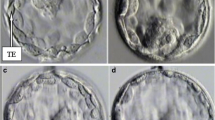Abstract
Purpose
To generate novel, objective variables that resemble embryo quality and relate them to ongoing implantation, using multilevel imaging of single-transferred embryos.
Methods
Retrospective analysis of multilevel images of 659 day 3 single-transferred embryos. Each embryo was photographed on seven different levels, in order to measure the largest diameter of every blastomere within an embryo. The volume of each blastomere was calculated using the equation \( 1/6\pi ^*\mathrm{diamete}{{\mathrm{r}}^3} \). The blastomere volume index (BVI) represented the ratio between the total blastomeric volume of an embryo and the mean cytoplasmic volume of an oocyte on day 0. The blastomere symmetry index (BSI) represented the ratio between the greatest blastomere volume and the smallest blastomere volume within an embryo. The mean ovality (MO) represented the presence of non-spherical blastomeres. Analyses were performed to compare the BVI, BSI and MO between patients with and without an ongoing implantation.
Results
The mean BVI was significantly higher for embryos in the ongoing implantation group compared to the no ongoing implantation group. The mean BSI was associated with ongoing implantation for unevenly cleaved embryos. The MO of blastomeres within an embryo was similar for embryos in the ongoing implantation group compared to the no ongoing implantation group. The association of the BVI and BSI with ongoing implantation was confounded, because only female age and cleavage rate were significantly associated with ongoing implantation in multiple logistic regression analyses.
Conclusions
The BVI, BSI and MO are objective variables that resemble embryo quality, but they are not suitable to use as embryo selection tools.

Similar content being viewed by others
References
Alikani M, Cohen J, Tomkin G, Garrisi GJ, Mack C, Scott RT. Human embryo fragmentation in vitro and its implications for pregnancy and implantation. Fertil Steril. 1999;71:836–42. doi:10.1016/S0015-282(99)00092-8.
Baczkowski T, Kurzawa R, Glabowski W. Methods of embryo scoring in in vitro fertilization. Reprod Biol. 2004;4:5–22.
Baxter Bendus AE, Mayer JF, Shipley SK, Catherino WH. Interobserver and intraobserver variation in day 3 embryo grading. Fertil Steril. 2006;86:1608–15. doi:10.1016/j.fertnstert.2006.05.037.
Cooke S, Quinn P, Kime L, Ayres C, Tyler JPP, Driscoll GL. Improvement in early human embryo development using new formulation sequential stage-specific culture media. Fertil Steril. 2002;78:1254–60. doi:10.1016/S0015-0282(02)04343-1.
Fujimoto VY, Browne RW, Bloom MS, Sakkas D, Alikani M. Pathogenesis, developmental consequences, and clinical correlations of human embryo fragmentation. Fertil Steril. 2010;95:1197–204. doi:10.1016/j.fertnstert.2010.11.033.
Garrisi GJ, Chin AJ, Dolan PM, Nagler HM, Vasquez-Levin M, Navot D, et al. Analysis of factors contributing to success in a program of micro-manipulation-assisted fertilization. Fertil Steril. 1993;59:366–74.
Goyanes VJ, Ron-Corzo A, Costas E, Maneiro E. Morphometric categorization of the human oocyte and early conceptus. Hum Reprod. 1990;5:613–8.
Hardarson T, Ahlström A, Rogberg L, Botros L, Hillensjö T, Westlander G, et al. Non-invasive metabolomic profiling of day 2 and 5 embryo culture medium: a prospective randomised trial. Hum Reprod. 2012;27:89–96. doi:10.1093/humrep/der373.
Hardarson T, Hanson C, Sjögren A, Lundin K. Human embryos with unevenly sized blastomeres have lower pregnancy and implantation rates: indications for aneuploidy and multinucleation. Hum Reprod. 2001;16:313–8. doi:10.1093/humrep/16.2.313.
Hnida C, Engenheiro E, Ziebe S. Computer-controlled, multilevel, morphometric analysis of blastomere size as biomarker of fragmentation and multinuclearity in human embryos. Hum Reprod. 2004;19:288–93. doi:10.1023/B:JARG.0000045473.80338.57.
Hnida C, Ziebe S. Total cytoplasmic volume as biomarker of fragmentation in human embryos. J Assist Reprod Genet. 2004;21:335–40. doi:10.1023/B:JARG.0000045473.80338.57.
Johansson M, Hardarson T, Lundin K. There is a cuttoff limit in diameter between a blastomere and a small anucleate fragment. J Assist Reprod Genet. 2003;20:309–13. doi:10.1023/A:1024805407058.
Mastenbroek S, Twisk M, van der Veen F, Repping S. Preimplantation genetic screening: a systematic review and meta-analysis of RCTs. Hum Reprod Update. 2011;17:454–66. doi:10.1002/14651858.CD005291.pub2.
Montag M, Liebenthron J, Köster M. Which morphological scoring system is relevant in human embryo development? Placenta. 2011;32:S252–6. doi:10.1016/j.placenta.2011.07.009.
Paternot G, Debrock S, D’Hooghe T, Spiessens C. Computer-assisted embryo selection: a benefit in the evaluation of embryo quality? Reprod Biomed Online. 2011;23:347–54. doi:10.1016/j.rbmo.2011.05.007.
Paternot G, Devroe J, Debrock S, D’Hooghe T, Spiessens C. Intra- and inter-observer analysis in the morphological assessment of early-stage embryos. Reprod Biol Endocrinol. 2009;7:105–10. doi:10.1186/1477-7827-7-105.
Roux C, Joanne C, Agnani G, Fromm M, Clavequin MC, Bresson JL. Morphometric papameters of living human in-vitro fertilisation embryos; importance of the asynchronous division process. Hum Reprod. 1995;10:1201–7.
Staessen C, Camus M, Bollen N, Devroey P, Van Steirteghem AG. The relationship between embryo quality and the occurrence of multiple pregnancies. Fertil Steril. 1992;57:626–30.
Van Royen E, Mangelschots K, De Neubourg D, Laureys I, Ryckaert G, Gerris J. Calculating the implantation potential of day 3 embryos in women younger than 38 years of age: a new model. Hum Reprod. 2001;16:326–32. doi:10.1093/humrep/16.2.326.
Vergouw CG, Kieslinger DC, Kostelijk EH, Botros LL, Schats R, Hompes PGA, et al. Day 3 embryo selection by metabolomic profiling of embryo culture media with near-infrared spectroscopy as an adjunct to morphology: a randomized controlled trial. Hum Reprod. 2012;27:2304–11. doi:10.1093/humrep/des175.
Ziebe S, Lundin K, Loft A, Bergh C, Nyboe Andersen A, Selleskog U, et al. FISH analysis for chromosomes 13, 16, 18, 21, 22, X and Y in all blastomeres of IVF pre-embryos from 144 randomly selected donated human embryos and impact on pre-embryo morphology. Hum Reprod. 2003;12:2575–81. doi:10.1093/humrep/deg489.
Ziebe S, Petersen K, Lindenberg S, Andersen AG, Gabrielsen A, Nyboe Andersen A. Embryo morphology or cleavage stage: how to select the best embryos for transfer after in-vitro fertilization. Hum Reprod. 1997;12:1545–9.
Conflict of interest
The authors declare that they have no conflict of interest.
Author information
Authors and Affiliations
Corresponding author
Additional information
Capsule The Blastomere Volume Index (BVI), Blastomere Symmetry Index (BSI) and Mean Ovality (MO) are objective tools to measure embryo quality, but appeared to be unsuitable as embryo selection tools.
Rights and permissions
About this article
Cite this article
Vergouw, C.G., Al Nofal, M., Kostelijk, E.H. et al. The association of the blastomere volume index (BVI), the blastomere symmetry index (BSI) and the mean ovality (MO) with ongoing implantation after single embryo transfer. J Assist Reprod Genet 30, 587–592 (2013). https://doi.org/10.1007/s10815-013-9970-8
Received:
Accepted:
Published:
Issue Date:
DOI: https://doi.org/10.1007/s10815-013-9970-8




